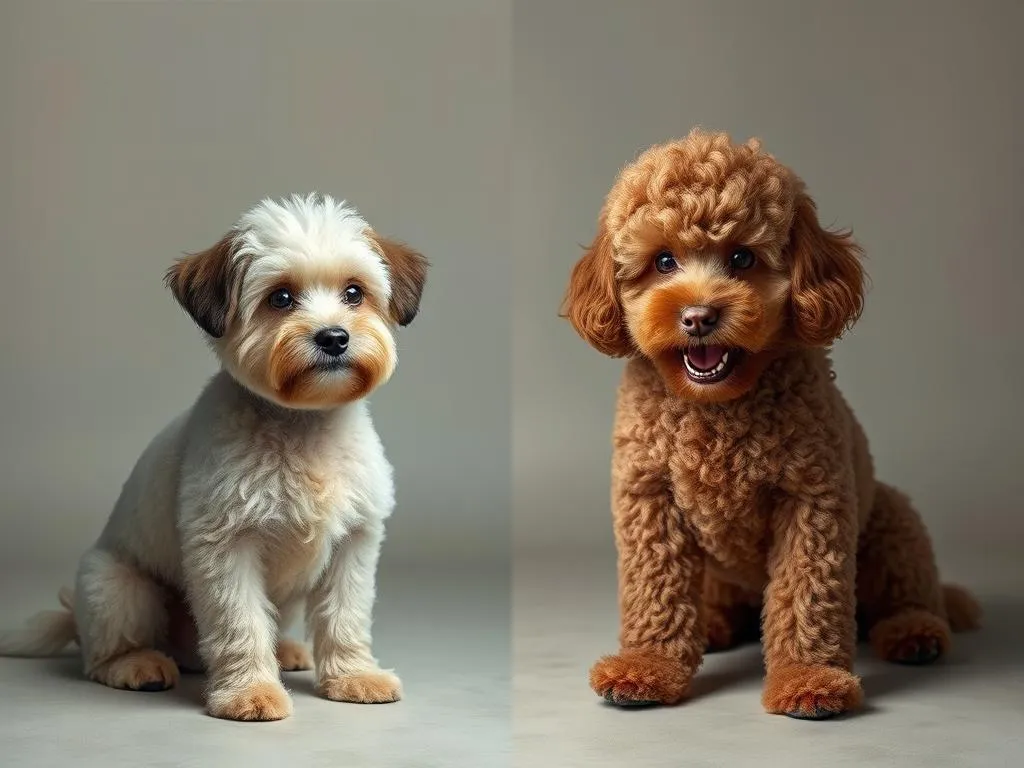
Introduction
When considering adding a furry friend to your family, the choice of breed can significantly impact your lifestyle. Among the countless breeds available, two popular options often come up in discussions: the Maltese and the Poodle. Both breeds have distinct characteristics and appeal, making them favorites for dog lovers everywhere.
The Maltese is known for its charming demeanor and elegant appearance, while the Poodle boasts intelligence and versatility. This article offers an in-depth comparison between these two breeds, exploring their origins, physical traits, temperament, grooming needs, and more.
General Overview of Each Breed
Maltese
Origin and History
The Maltese breed traces its roots back to the ancient Mediterranean, specifically Malta, where it was cherished by nobility and adored as a companion dog. Over the centuries, the Maltese has played a significant role in various cultures, often depicted in art and literature. Known for their loyalty and playful nature, these dogs have been companions for many prominent figures in history.
Physical Characteristics
Maltese dogs are small, typically weighing between 4 to 7 pounds. They stand about 8 to 10 inches tall at the shoulder. One of their most striking features is their long, flowing, silky white coat, which requires regular grooming. They have a rounded skull, dark eyes, and a distinctive black nose that gives them an adorable, expressive look.
Temperament and Behavior
The Maltese is known for its affectionate and lively personality. They are often described as playful, gentle, and friendly. These dogs thrive on companionship and are known to form strong bonds with their families. While they are generally good with children, their small size makes them better suited for families that can supervise playtime.
Poodle
Origin and History
The Poodle has a fascinating history that dates back to the 15th century in Germany, where they were initially bred as water retrievers. The breed’s name comes from the German word “Pudel,” meaning “to splash.” Poodles come in three sizes: Standard, Miniature, and Toy, each bred for different purposes and lifestyles. Their intelligence and versatility have made them beloved companions, service dogs, and show dogs worldwide.
Physical Characteristics
Poodles are known for their elegant appearance and come in a variety of sizes:
– Standard Poodles: 45 to 70 pounds, 15 inches or taller.
– Miniature Poodles: 10 to 15 pounds, 10 to 15 inches tall.
– Toy Poodles: 4 to 6 pounds, 10 inches or shorter.
Their coats are distinctive, featuring tight, curly fur that can come in various colors, including black, white, apricot, and gray. Poodles require regular grooming to maintain their coats and prevent matting.
Temperament and Behavior
Poodles are highly intelligent, energetic, and eager to please. They are known for their friendly demeanor and adaptability, making them excellent companions for families, singles, and seniors alike. Poodles thrive on mental stimulation and exercise, which helps keep them happy and well-behaved. Their sociable nature often makes them friendly with both humans and other pets.
Comparison of Maltese and Poodle
Size and Weight
When it comes to size, the Maltese is significantly smaller than the Poodle. The average Maltese weighs between 4 to 7 pounds, while Poodles vary from 4 to over 70 pounds, depending on the size category.
- Maltese: Small and lightweight, ideal for apartment living.
- Poodle: Available in multiple sizes, making them adaptable to different living spaces.
For individuals living in small apartments, the Maltese may be the better choice due to their compact size. However, a Standard Poodle can also thrive in larger homes with sufficient space for exercise.
Coat and Grooming Needs
The coats of the Maltese and Poodle differ significantly in texture and maintenance.
- Maltese coat: Long, silky, and straight, requiring daily brushing to prevent tangles and matting.
- Poodle coat: Curly and dense, which requires regular grooming every 4 to 6 weeks to maintain its shape and prevent matting.
Both breeds require a commitment to grooming, but the Maltese generally needs more frequent brushing due to their longer hair. Grooming costs can vary, with Poodles requiring more specialized care due to their unique coat type.
Temperament Comparison
When comparing temperament, both breeds offer affectionate and playful natures, but there are differences in energy levels and training ease.
- Maltese: Generally more laid-back and may enjoy cuddling on the couch, though they still require playtime.
- Poodle: Highly energetic and intelligent, needing regular exercise and mental stimulation.
For families with children, the Poodle might be a better fit due to their high energy and playfulness. However, the Maltese can also adapt well in a family setting, given proper supervision during playtime.
Health Considerations
Both the Maltese and Poodle have their share of breed-specific health issues.
- Maltese Health Issues: They are prone to dental problems, patellar luxation, and certain skin conditions. Regular veterinary check-ups and dental care are essential.
- Poodle Health Issues: Common health concerns include hip dysplasia, progressive retinal atrophy, and certain skin conditions.
Both breeds have a similar lifespan of around 12 to 15 years, but maintaining their health requires attention to diet, exercise, and regular veterinary care.
Training and Socialization
Training Approaches
Training is crucial for both breeds, but they respond differently to various methods.
- Maltese: Can be stubborn at times, requiring patience and consistency during training. Positive reinforcement works best.
- Poodle: Highly intelligent and eager to learn, making them quick to pick up commands and tricks.
For effective training, both breeds benefit from early socialization and consistent routines. Engaging training sessions that incorporate play can enhance learning for both the Maltese and Poodle.
Socialization Needs
Socialization is vital for both breeds to develop well-rounded temperaments.
- Maltese: Early exposure to different environments, people, and pets can help reduce shyness or overprotectiveness.
- Poodle: Socialization is essential to channel their energy positively, helping them interact well with various situations.
Activities such as puppy classes, dog parks, and playdates can be beneficial for both breeds, fostering healthy social behavior.
Cost of Ownership
Initial Purchase Price
The initial purchase price for both breeds can vary significantly based on factors like breeder reputation, lineage, and location.
- Maltese: Typically range from $1,500 to $3,000.
- Poodle: Standard Poodles can range from $1,000 to $2,500, while Miniature and Toy Poodles may vary from $1,000 to $3,000.
Potential owners should research reputable breeders and consider adopting from shelters or rescues to find a loving companion.
Ongoing Expenses
Ongoing costs for both breeds include food, grooming, and healthcare.
- Food Costs: Both breeds require high-quality dog food. Expect to spend around $30 to $60 a month.
- Grooming Costs: Regular grooming can range from $50 to $150 per session, depending on the breed and the type of grooming needed.
- Healthcare Costs: Routine veterinary visits can average around $200 to $500 annually, not including unexpected health issues.
Budgeting for unexpected health problems is crucial, and pet insurance can help mitigate these costs.
Conclusion
In summary, both the Maltese and Poodle have unique traits that make them exceptional companions. The Maltese is a small, affectionate breed that thrives on companionship, while the Poodle is intelligent, versatile, and energetic.
Choosing between the two ultimately depends on your lifestyle, living situation, and personal preferences. For those who prefer a smaller, cuddly companion, the Maltese may be ideal. Conversely, if you seek an active, intelligent dog that enjoys play and training, the Poodle could be the better choice.
No matter which breed you choose, both the Maltese and Poodle promise to bring joy and companionship into your life.
FAQs
What are the main differences between Maltese and Poodles?
The primary differences lie in size, coat type, grooming needs, and temperament. Maltese are smaller and have long, silky coats, while Poodles come in various sizes with curly coats.
Are Maltese or Poodles better for families?
Both breeds can be great for families, but Poodles may be more suitable for active families due to their energy levels, while Maltese are better for families who prefer a more laid-back companion.
How much grooming do Maltese and Poodles require?
Maltese require daily brushing and regular grooming, while Poodles need grooming every 4 to 6 weeks and regular brushing to prevent matting.
What are common health issues for Maltese and Poodles?
Maltese are prone to dental issues and patellar luxation, while Poodles may experience hip dysplasia and progressive retinal atrophy.
How long do Maltese and Poodles typically live?
Both breeds have a lifespan of around 12 to 15 years, depending on general health and care.









